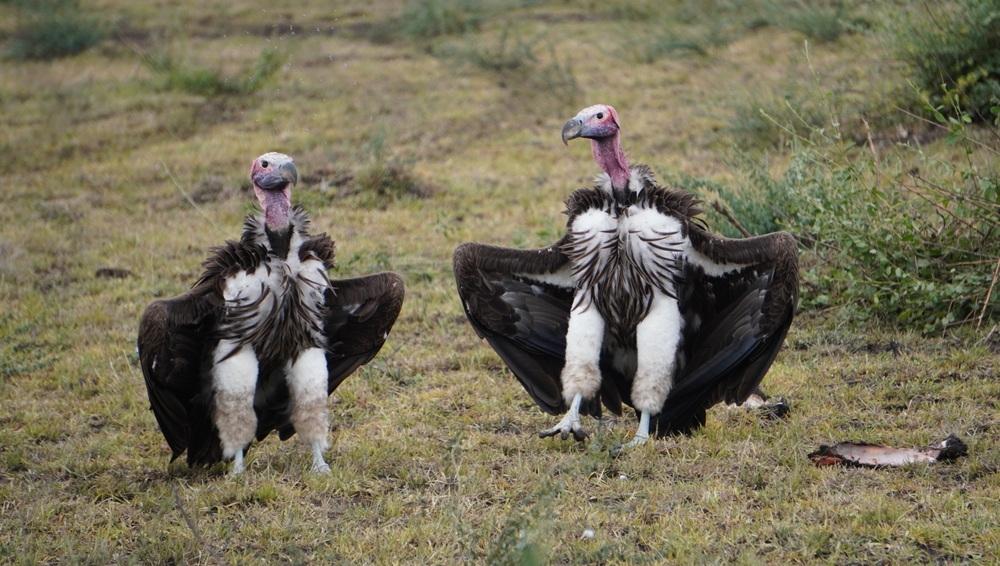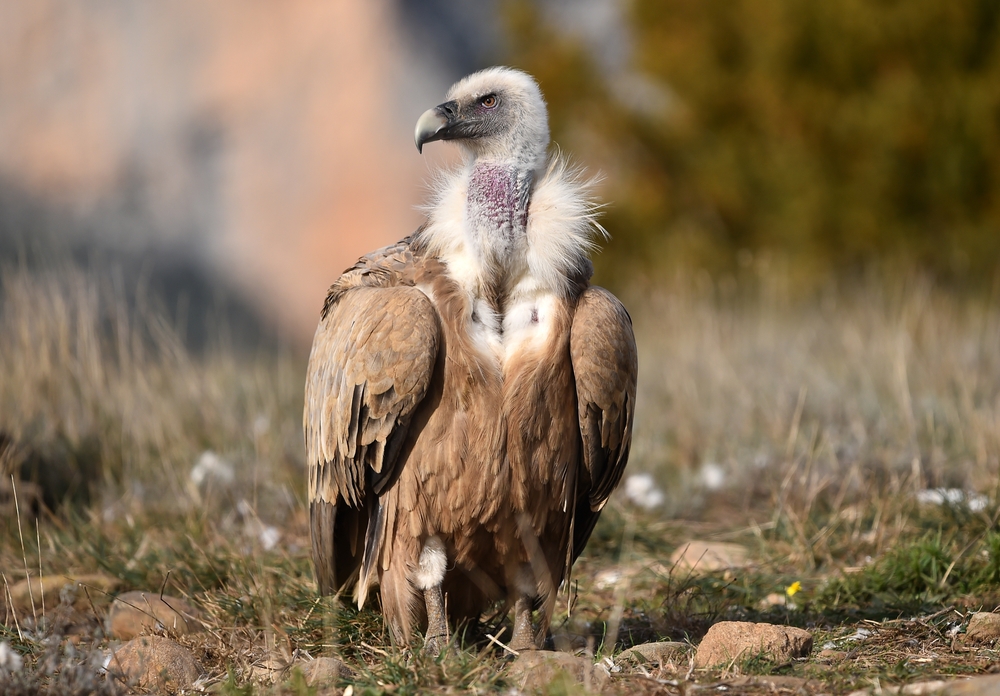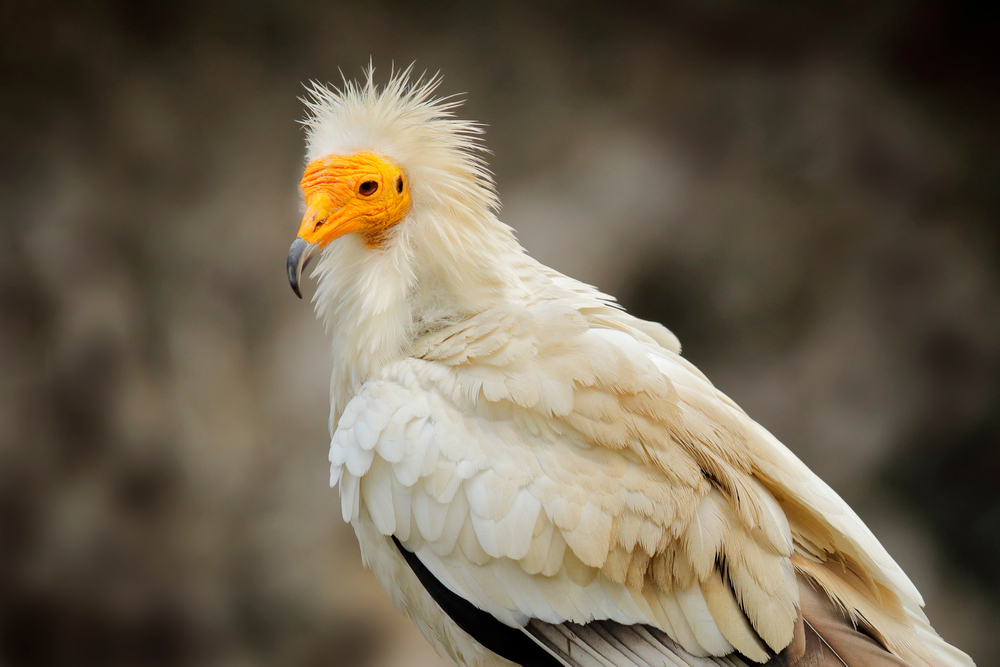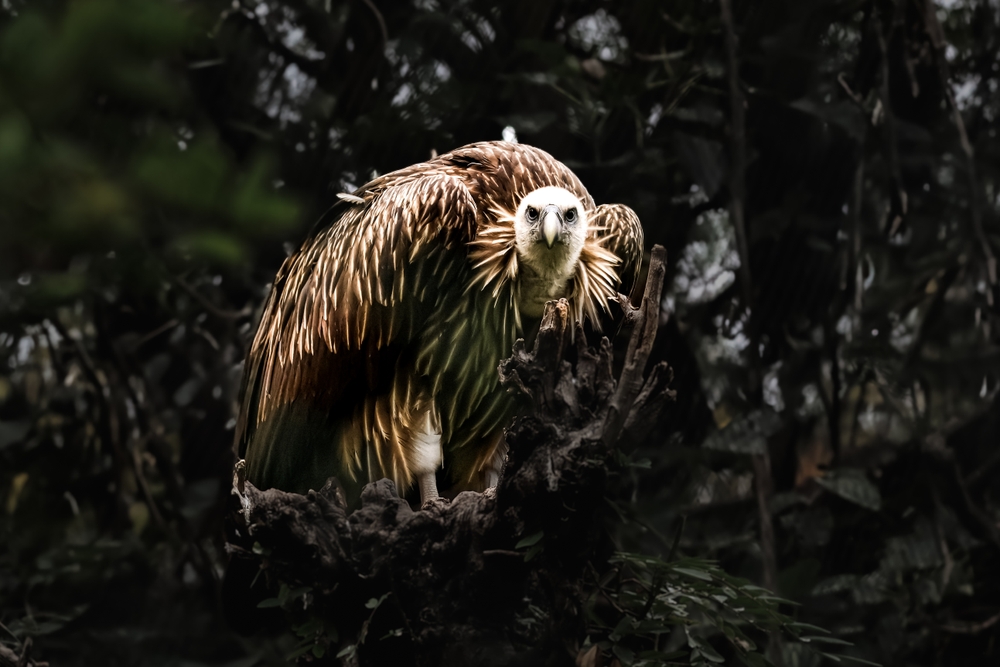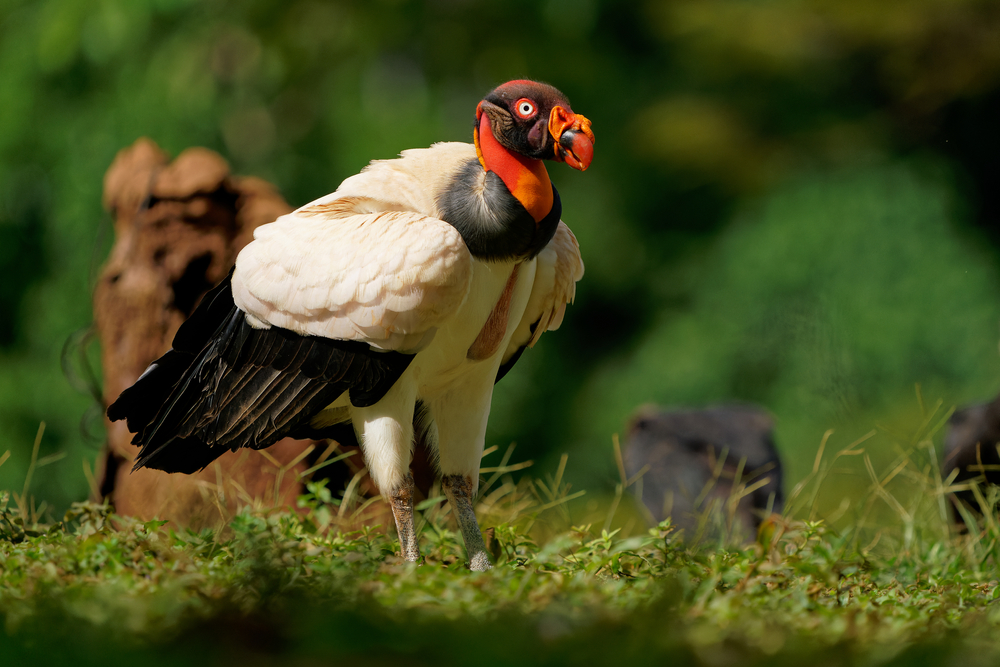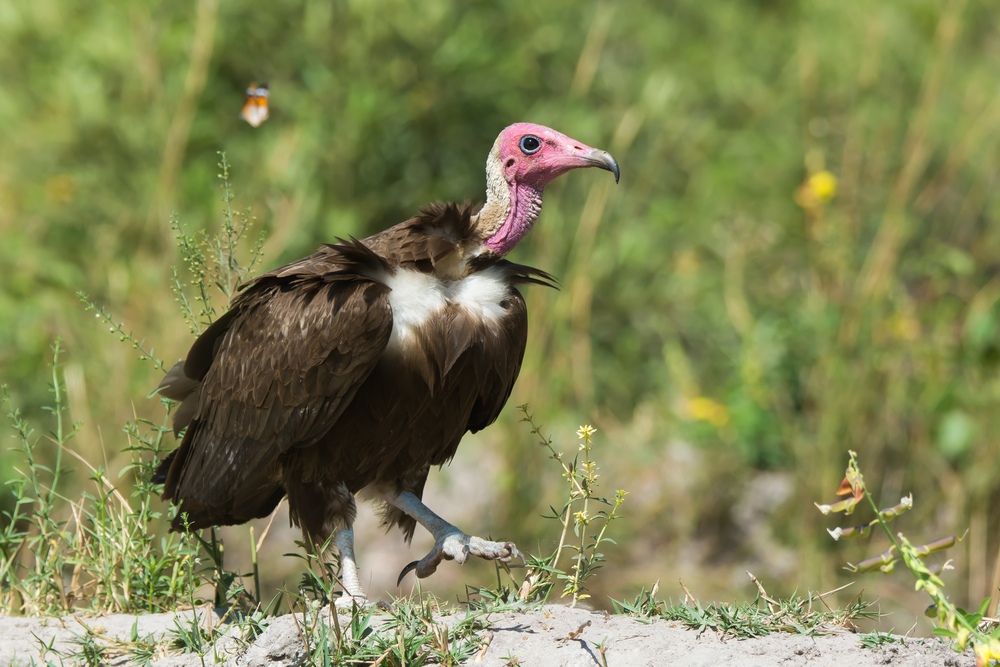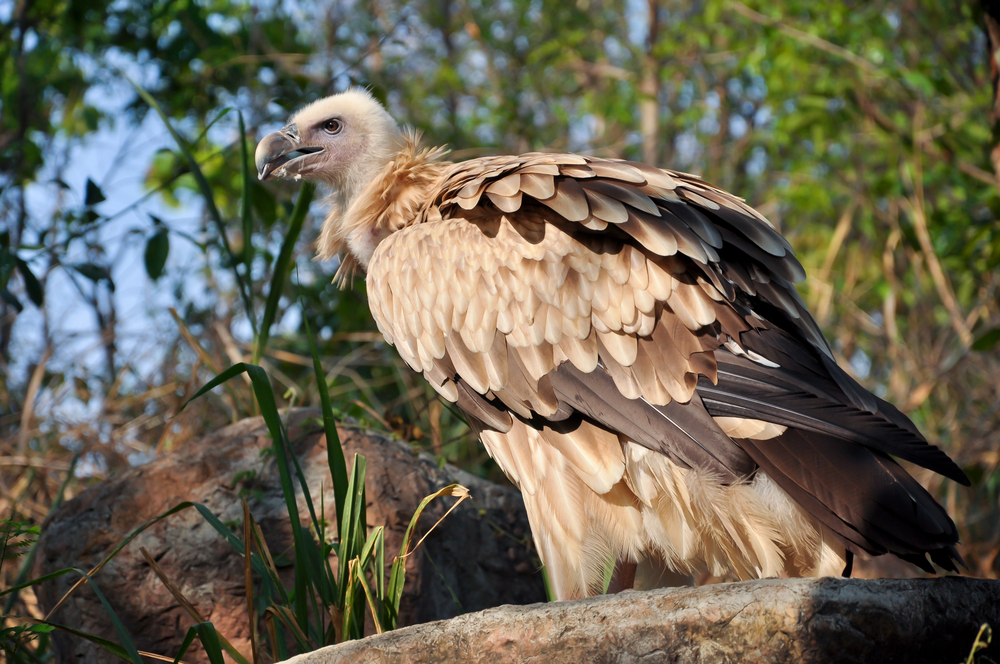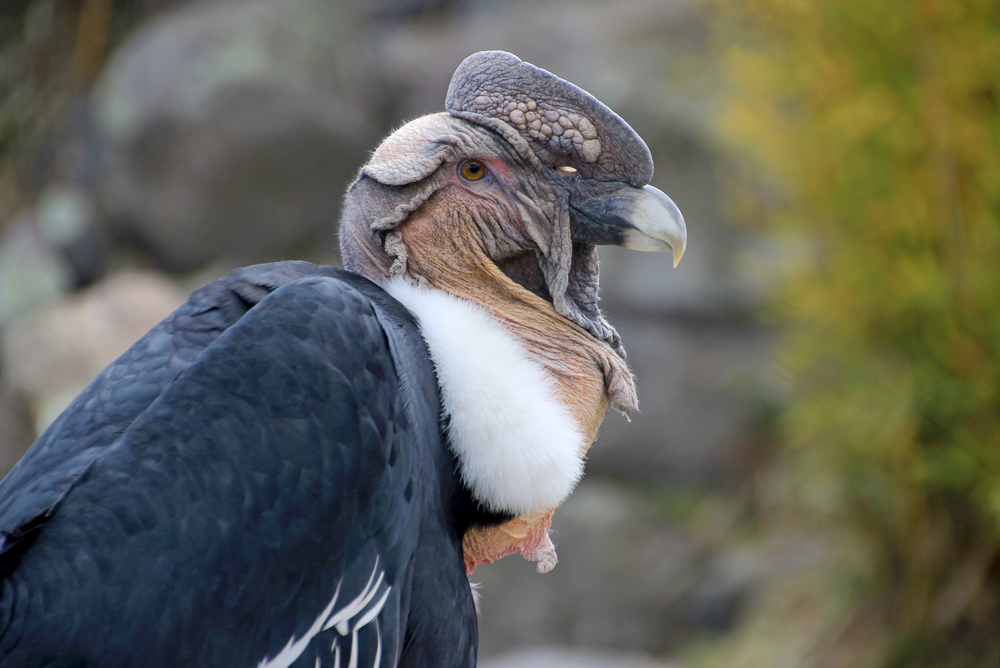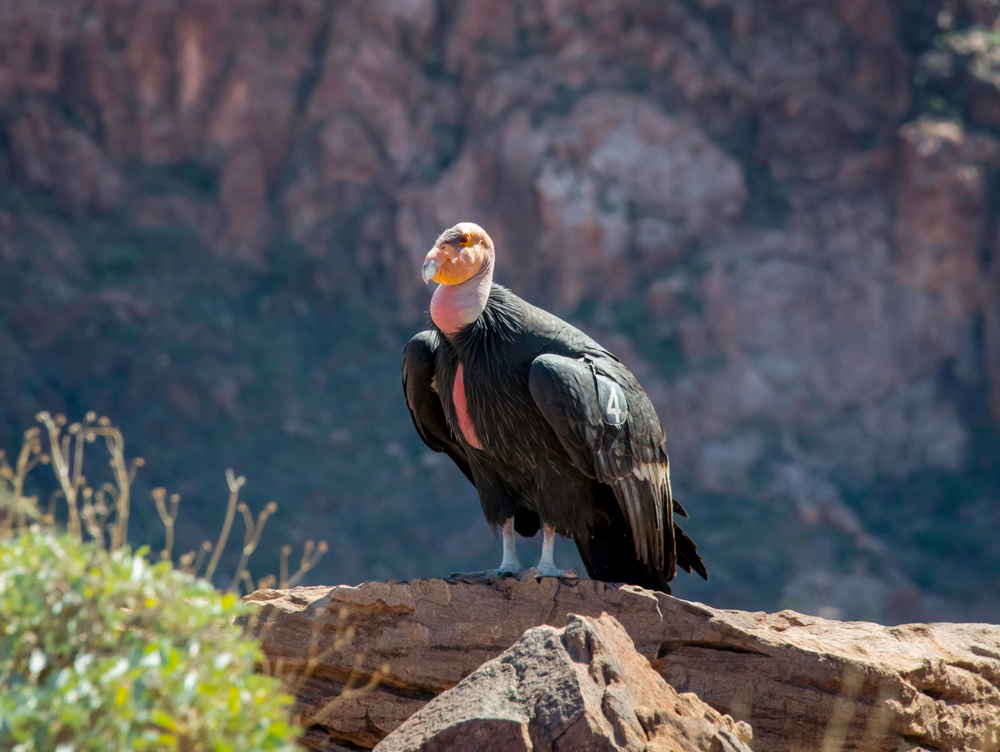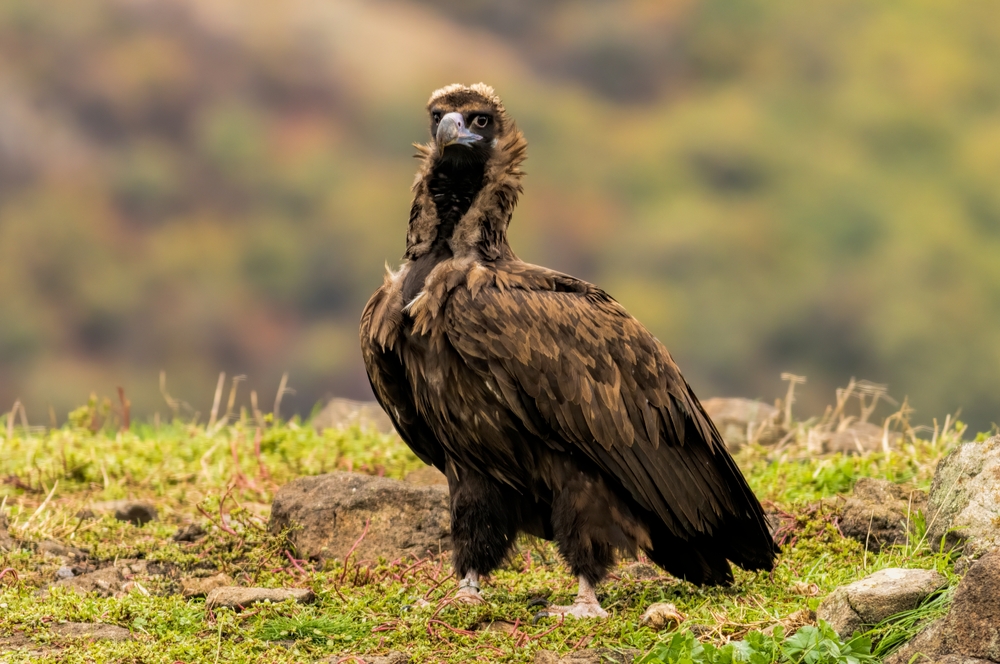The Lappet-faced Vulture (Torgos tracheliotos) is the sole member of its genus, but its closest relatives are other Old World vultures in the family Accipitridae, particularly the White-headed Vulture and the Griffon Vulture.
About
The Lappet-faced Vulture (Torgos tracheliotos), a member of the Accipitridae family, is one of the largest and most powerful Old World vultures. Native to Africa and parts of the Arabian Peninsula, this imposing bird is often considered the “king” of African vultures because of its size, strength, and dominance at carcasses. Its presence is crucial for maintaining healthy ecosystems by efficiently disposing of carrion.
Measuring 95–115 cm (37–45 in) in length with an impressive wingspan of 2.5–2.9 meters (8.2–9.5 ft), the Lappet-faced Vulture can weigh up to 9.5 kg (21 lbs). It is easily recognized by its massive size, broad wings, strong hooked bill, and bare pinkish to reddish head adorned with large folds of skin, or “lappets,” from which it takes its name. Its plumage is generally dark brown to black, with contrasting white thighs.
Unlike smaller vultures that often rely on scraps, the Lappet-faced Vulture is equipped with one of the strongest bills of any raptor, capable of tearing into the hides and bones of large animals. This allows it to access parts of a carcass that others cannot, making it a keystone species at feeding sites. It dominates over other vultures but also coexists with them by opening tough carcasses that smaller species later exploit.
Breeding typically occurs in solitary pairs, often nesting in tall acacia or other large trees. Their nests are large stick platforms, where a single egg is laid. Both parents share incubation and care of the chick, which takes months to fledge and remains dependent for some time.
Once widespread, the Lappet-faced Vulture has suffered steep declines due to poisoning, habitat loss, hunting, and persecution. It is now listed as Endangered, with conservation efforts focusing on protecting nesting sites, reducing poisoning incidents, and preserving its savanna and semi-desert habitats.
Physical Characteristics
Lappet-faced Vultures are among the largest and most powerful of all Old World vultures, recognized for their imposing size and distinctive facial features:
Head and Face:
They have a bare head with wrinkled skin folds, or “lappets,” on the sides of their neck and face, giving them their name. The skin coloration ranges from pink to reddish, often becoming more vivid during displays or agitation.
Beak:
Their beak is massive, strong, and sharply hooked—one of the most powerful among vultures. It enables them to tear through the thick hides, tendons, and bones of large carcasses that smaller scavengers cannot penetrate.
Plumage:
Lappet-faced Vultures have dark brown to black plumage covering most of their body, with contrasting white thighs and legs. Young birds are darker, almost black, while adults show lighter plumage with age.
Body and Build:
They are heavy-bodied with broad wings and a muscular chest, built for dominance at carcasses. Their strong legs and large talons add to their commanding presence.
Size:
-
Length: 37 to 45 in (95 to 115 cm)
-
Wingspan: 8.2 to 9.5 ft (2.5 to 2.9 m)
-
Weight: 14 to 31 lbs (6.5 to 14 kg)
The Lappet-faced Vulture’s formidable size, powerful beak, and commanding presence make it the “muscle” among vultures. They often open carcasses first, allowing smaller vultures and scavengers to feed afterward.
Reproduction
The reproductive cycle of the Lappet-faced Vulture reflects its slow breeding strategy, typical of large raptors:
1. Courtship and Pair Bonding:
Lappet-faced Vultures are monogamous, forming long-term pair bonds. Courtship displays include soaring together, circling flights, and mutual preening near nesting sites.
2. Breeding Season:
Breeding timing varies by region but generally occurs during the dry season when food is more abundant and nesting conditions are favorable.
3. Nesting:
Pairs build large nests made of sticks and lined with grass, often placed in tall, flat-topped acacia or baobab trees, cliffs, or other elevated sites. These nests can measure over 6.5 ft (2 m) in diameter and are reused and repaired each year.
4. Egg Laying:
The female typically lays a single egg per breeding cycle. Both parents share responsibilities in incubation.
5. Incubation:
The incubation period lasts about 54 to 56 days, with both male and female alternating duties to keep the egg protected and warm.
6. Chick Development:
The chick is covered in white down at hatching and is completely dependent on its parents. Both adults regurgitate food directly into the chick’s beak.
7. Fledging and Independence:
The young vulture fledges at about 3.5 to 4 months of age but often remains dependent on parental feeding and protection for several additional months. Sexual maturity is not reached until around 5 to 6 years of age.
The Lappet-faced Vulture’s low reproductive rate—one egg and prolonged parental care—makes its populations especially vulnerable to environmental threats and human pressures.
Lifespan
The Lappet-faced Vulture is a long-lived bird of prey, with survival depending greatly on environmental pressures and human impact.
Lifespan in the Wild:
In their natural savanna and desert habitats, Lappet-faced Vultures generally live up to 30 years. Their longevity depends on food availability, safe nesting sites, and avoidance of poisoning or persecution.
Lifespan in Captivity:
In zoos and wildlife sanctuaries, with steady food supplies and veterinary care, they may live longer—often reaching 40 to 50 years.
Threats to the Lappet-faced Vulture:
-
Poisoning: Indirect poisoning from poisoned carcasses set out for predators is a major cause of mortality.
-
Habitat Loss: Expanding agriculture and urbanization reduce nesting and foraging grounds.
-
Persecution: In some areas, they are hunted or disturbed due to misconceptions or human conflict.
-
Food Scarcity: Declines in wild herbivores and livestock carcass availability reduce their food base.
-
Electrocution and Collisions: Power lines and wind turbines pose growing risks.
Because they reproduce slowly and invest heavily in raising a single chick, Lappet-faced Vultures are particularly vulnerable to population declines. Conservation measures such as anti-poisoning campaigns, protected nesting areas, and habitat management are essential for their survival.
Eating Habits
Lappet-faced Vultures are dominant scavengers with specialized feeding habits that reflect their size and strength:
Diet:
They primarily feed on carrion, including the carcasses of large ungulates such as antelope, wildebeest, and livestock. Thanks to their massive beaks, they can tear through thick hides, tendons, and even small bones that most other vultures cannot manage. In times of scarcity, they may also prey opportunistically on weakened or newborn animals, bird eggs, or small reptiles.
Feeding Strategy:
Unlike Turkey Vultures, which rely heavily on smell, Lappet-faced Vultures depend on keen eyesight to locate food while soaring over open landscapes. They often follow the activity of other scavengers to find carcasses.
Role at Carcasses:
They are usually the first to feed, using their strength and powerful bills to open up carcasses. This allows smaller vultures—such as White-backed or Hooded Vultures—to access softer tissues once the hide is breached.
Social Behavior at Feeding Sites:
Highly dominant, Lappet-faced Vultures often displace other vultures at carcasses. Their aggressive behavior and sheer size ensure they get priority feeding rights, though multiple species frequently gather at large kills.
Feeding Technique:
They rip large chunks of flesh from carcasses and consume them quickly. Their digestive system is adapted to handle tough tissues and potentially contaminated meat without harm.
The Lappet-faced Vulture’s powerful feeding ability and dominance at carcasses make it one of the most important species for nutrient recycling in African ecosystems.
Uniqueness
The Lappet-faced Vulture (Torgos tracheliotos) is one of Africa’s most distinctive and commanding vultures, with features that set it apart from all others:
Powerful Beak:
It has the strongest beak of any Old World vulture, capable of tearing into the hides, tendons, and bones of large carcasses that smaller vultures cannot penetrate.
Wrinkled “Lappets”:
The bare, pinkish-red head and neck are lined with wrinkled folds of skin called lappets, which not only inspire its name but also help keep the bird cool and clean while feeding.
Dominance at Carcasses:
Their size, aggression, and strength make them the top-ranking scavenger at feeding sites. Smaller vultures, such as Hooded or White-backed Vultures, often wait until the Lappet-faced has opened a carcass.
Largest African Vulture:
With a wingspan approaching 9.5 ft (2.9 m), they are the largest vultures in Africa, surpassed in size only by the Andean and California Condors globally.
Opportunistic Behavior:
Unlike most vultures that strictly scavenge, Lappet-faced Vultures occasionally hunt small animals, tortoises, or the young of other bird species, making them one of the few vultures to supplement carrion with live prey.
Conservation Significance:
The species is classified as Endangered due to poisoning, habitat loss, and persecution. Its slow reproduction and dependence on large territories make conservation efforts critical.
The Lappet-faced Vulture’s commanding presence, ecological importance, and unique physical features distinguish it as one of the most remarkable scavengers in the world.
Be the First to Share Photos of This Species.
FAQ’s
1. What species is closest to the Lappet-faced Vulture?
2. How does the Lappet-faced Vulture compare to other vultures?
It is Africa’s largest vulture, with a wingspan up to 9.5 ft (2.9 m) and the most powerful beak of any Old World vulture.
Unlike most species that rely solely on carrion, Lappet-faced Vultures sometimes prey on live animals, making them more versatile than most scavengers. Their dominance at carcasses sets them apart as the “muscle” of the vulture community.
3. What national parks provide the best opportunity to see a Lappet-faced Vulture?
Lappet-faced Vultures are found across Africa’s savannas and semi-deserts. Some of the best national parks to view them include:
-
Serengeti National Park, Tanzania
-
Kruger National Park, South Africa
-
Etosha National Park, Namibia
-
Masai Mara National Reserve, Kenya
-
Hwange National Park, Zimbabwe
These wide, open habitats with abundant large mammals provide ideal conditions for spotting this powerful vulture soaring overhead or feeding at carcasses.



































































